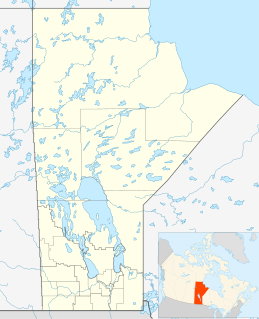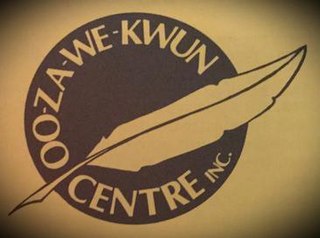
The Saulteaux are a First Nations band government in Ontario, Manitoba, Saskatchewan, Alberta and British Columbia, Canada. They are a branch of the Ojibwe when they pushed west forming into a mixed culture of woodlands and plains Indigenous customs and traditions.

The Assiniboine River is a 1,070-kilometre (660 mi) river that runs through the prairies of Western Canada in Saskatchewan and Manitoba. It is a tributary of the Red River. The Assiniboine is a typical meandering river with a single main channel embanked within a flat, shallow valley in some places and a steep valley in others. Its main tributaries are the Qu'Appelle, Souris and Whitesand Rivers. For early history and exploration see Assiniboine River fur trade.
First Nation Operated Schools in Manitoba and the rest of Canada are schools that are funded by the Government of Canada. In accordance with the Treaty arrangements between the federal government and most individual First Nations, First Nation Operated Schools must be administered by locally elected School boards, and operate outside the direct control of the local Chief and Band Council.
Indigenous Police in Canada are police forces responsible for public order on First Nations across Canada.
Yellow Quill First Nation is a Saulteaux First Nation band government in Saskatchewan, Canada. Their reserve is twelve miles northwest of Kelvington. The Yellow Quill First Nation is a signatory of Treaty No. 4, which was signed by Chief Yellow-quill on August 24, 1876.

Treaty 4 is a treaty established between Queen Victoria and the Cree and Saulteaux First Nation band governments. The area covered by Treaty 4 represents most of current day southern Saskatchewan, plus small portions of what are today western Manitoba and southeastern Alberta. This treaty is also called the "Qu'Appelle Treaty," as its first signings were conducted at Fort Qu'Appelle, North-West Territories, on 15 September 1874. Additional signings or adhesions continued until September 1877. This treaty is the only indigenous treaty in Canada that has a corresponding indigenous interpretation.

Deer Lake First Nation is an Oji-Cree First Nations band government in Northern Ontario, located north of Red Lake, Ontario Canada. It is one of the few First Nations in Ontario to have signed Treaty 5. It is part of the Keewaytinook Okimakanak Council and the Nishnawbe Aski Nation. As of December, 2007, the First Nation had 1,072 registered members, of which their on-reserve population was 868.
The Long Plain First Nation is an Ojibway First Nations band government whose reserve is located in the Central Plains region of Manitoba, Canada. It is located to the southwest of Portage la Prairie along the Assiniboine River. It lies between the Rural Municipality of Portage la Prairie and the Rural Municipality of South Norfolk, and also borders another band's Indian reserve, that of the Dakota Plains First Nation. The 2006 census reported a population of 752 residents. The lands of the First Nation include the Long Plain Reserve #6, the Keeshkeemaquah Reserve near Portage La Prairie, and the Madison Indian Reserve #1 on the west side of Winnipeg.
Yellowquill College is Manitoba's first First Nations-controlled post-secondary institution. The First Nation owned and operated college was founded in October 1984, by the Dakota Ojibway Tribal Council.
The Dakota Ojibway Tribal Council (DOTC) is an organization of First Nations communities in Manitoba, Canada. Its mission statement indicates that the council's purpose is to "facilitate in the transfer of local control and responsibility of programs and services to member bands".
Fishing Lake First Nation is a First Nation of the Saulteaux branch of the Ojibwe nation. The band can trace their origins to central Canada, and were pushed westward to avoid encroachment by European settlers. The First Nation was originally part of the Yellow-quill Saulteaux Band, a Treaty Band named after a Treaty 4 signatory Chief Ošāwaškokwanēpi, whose name means "Green/Blue-quill." However, due to "š" merging with "s" in Nakawēmowin, this led to a mistranslation of his name as "Yellow-quill"—"yellow" being osāw-, while "green/blue" being ošāwaško-. The band was given three reserves, at Fishing and Nut Lakes and Kinistino, Saskatchewan. The Fishing Lake Indian Reserve 89 was approximately 22,850 acres (92.5 km2). Soon after the death of Chief Ošāwaškokwanēpi, the Band divided into three groups, the Fishing Lake First Nation, the Yellow Quill First Nation, and the Kinistin Saulteaux Nation

The Kinistin Saulteaux Nation is a Saulteaux band government in Saskatchewan. Their reserve is 39 kilometres (24 mi) southeast of Melfort. The Kinistin Saulteaux Nation is a signatory of Treaty No. 4, which was signed by Chief Yellow-quill on August 24, 1876.

Sandy Bay First Nation is an Ojibway/mixed-blood First Nation in Manitoba, Canada. As of the 2016 Canadian Census, it had a population of 2,515.

The Cote First Nation is a Saulteaux First Nations band government in Kamsack, Saskatchewan. This Saulteaux reserve is connected to the Keeseekoose First Nation and only a couple of miles from the Key First Nation. Their land is situated just south of the boreal forest in the aspen parkland ecosystem of Canada. The Ojibwe of this region of Saskatchewan and Manitoba, were both hunters of the plains bison and hunters of the forests which were more abundant during the 19th century. They also fished the endless lakes and other waterways in their country. They seldom went hungry as a result of the large bison herds. However, by the 1870s, commercial hunting had reduced the bison to near extinction and the Ojibwe of Saskatchewan and Manitoba began to suffer from famine.
The Keeseekoose First Nation is a Saulteaux band government located in Kamsack, Saskatchewan. The band is named for Chief Kiishikouse, who signed an adhesion to Treaty 4 at Swan Lake, Manitoba, in 1875. Flooding on the band's Manitoba reserve forced a relocation to the band's current location, adjacent to the Cote First Nation reserve. Those who stayed in Manitoba are today known as the Pine Creek First Nation.
Chief Kinistin was an Ojibway councilor (headman) of Chief Ošāwaškokwanēpi (Yellow-quill).

The Treaty Four Reserve Grounds 77 are an Indian reserve in Saskatchewan, Canada, shared by 33 band governments from Saskatchewan and Manitoba. The Reserve Grounds are located adjacent to and west of Fort Qu'Appelle. In the 2016 Canadian Census, they recorded a population of 15 living in 6 of their 8 total private dwellings.
The Saskatoon Tribal Council is a tribal council in the Treaty 6 Territory representing seven First Nation band governments in the province of Saskatchewan. Its head offices are located in the city of Saskatoon.

The Oo-za-we-kwun Centre at Rivers, Manitoba, Canada, was a vocational training center for Canadian First Nations people located on the abandoned Canadian Forces Base Rivers. The Centre was designed to be a unique and innovative experiment to improve the well-being of Canada's poorest demographic group.








